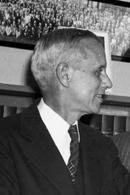Edmund Ware Sinnott
Edmund Ware Sinnott (born February 5, 1888 in Cambridge (Massachusetts) , † January 6, 1968 in New Haven (Connecticut) ) was an American botanist and philosopher of biology. Its official botanical author's abbreviation is " Sinnott ".
Sinnott graduated from Harvard University with a bachelor's degree in 1908, a master's degree in 1910 and a doctorate in 1913. He was at Harvard student of EC Jeffrey (who pursued a program of reclassification of plants based on comparative anatomy) and 1910-1911 with a travel grant in Australia and Asia with fellow student Arthur J. Eames . He was then an instructor at Harvard (Harvard Forestry School and Bussey Institution) and was from 1915 at the Connecticut Agricultural College in Storrs, which was then a center of genetic research in New England (there LC Dunn worked on the genetics of poultry) and where he was a professor for botany and genetics (succeeding Albert F. Blakeslee , who went to Cold Spring Harbor). He himself studied the genetics of cucurbits. From 1928 he was professor of botany at Barnard College, Columbia University . There he also succeeded the geneticist Thomas Hunt Morgan , who moved to Caltech. From 1940 he was Sterling Professor of Botany at Yale University , where he was also director of the Marsh Botanical Garden from 1940 to 1950 and Dean of the Graduate School from 1950 to 1956. From 1945 until his retirement in 1956 he was director of the Sheffield Scientific School at Yale.
He was the editor of the American Journal of Botany and published some widely used textbooks on botany and genetics (the textbook on genetics by himself and LC Dunn has been translated into many languages). Philosophically, he took a holistic (non-reductionist) view of living beings ( organicism ) and saw an overarching organizing force at work in them.
In his botanical work he tried to combine morphogenesis with genetics.
Sinnott was a member of the National Academy of Sciences , the American Philosophical Society, and the American Academy of Arts and Sciences, and was President of the Botanical Society of America, the American Society of Naturalists, and the American Association for the Advancement of Science .
Fonts
- Botany, Principles and Problems , McGraw Hill 1923, 6th edition 1963 (later editions with Katherine Wilson), Archives
- with Leslie C. Dunn: Principles of Genetics , McGraw Hill 1925, 3rd edition 1934 (later editions with Theodosius Dobzhansky )
- Cell and Psyche. The Biology of Purpose , University of North Carolina Press 1950, (John Calvin McNair Lectures), Archives
- Two Roads to Truth. A Basis of Unity under the great tradition , Viking Press 1953
- The Biology of the Spirit , Viking Press 1955
- Matter, Mind, and Man. The Biology of Human Nature , Harper 1957
- Plant Morphogenesis , McGraw Hill 1960, Archives
- Meetinghouse & Church in Early New England , 1963
- The Problem of Organic Form , Yale University Press 1963
- The Bridge of Life: From Matter to Spirit , Simon and Schuster 1966
Web links
| personal data | |
|---|---|
| SURNAME | Sinnott, Edmund Ware |
| BRIEF DESCRIPTION | American botanist and philosopher of biology |
| DATE OF BIRTH | February 5, 1888 |
| PLACE OF BIRTH | Cambridge, Massachusetts |
| DATE OF DEATH | January 6, 1968 |
| Place of death | New Haven (Connecticut) |
